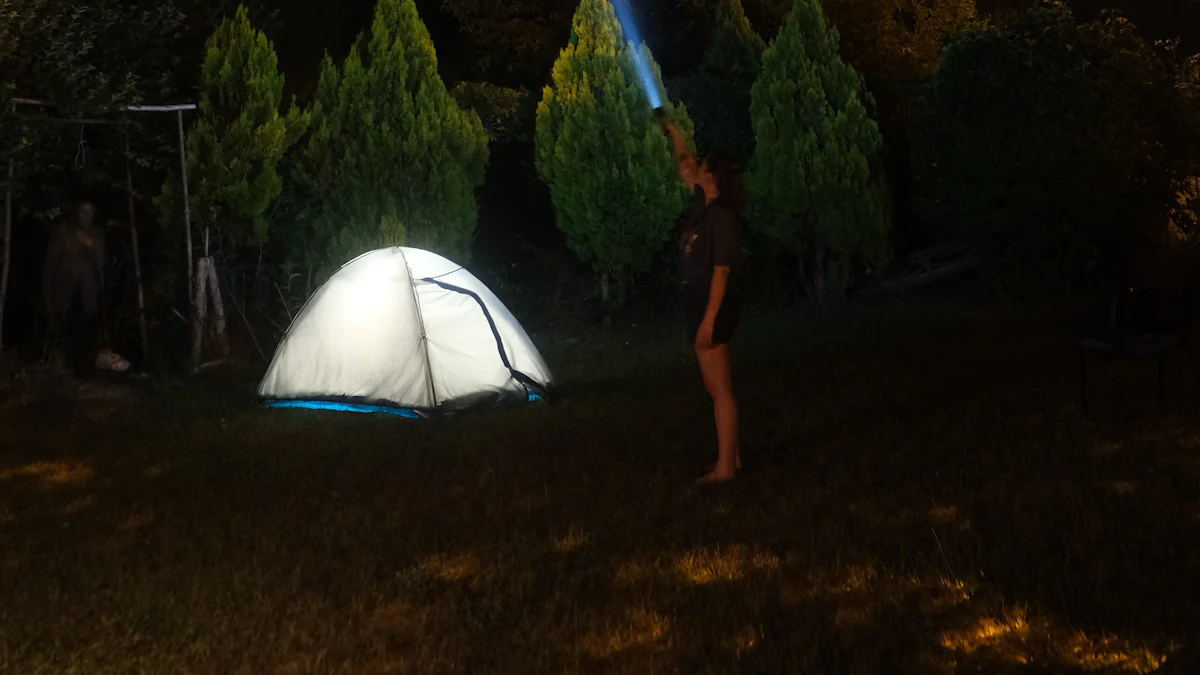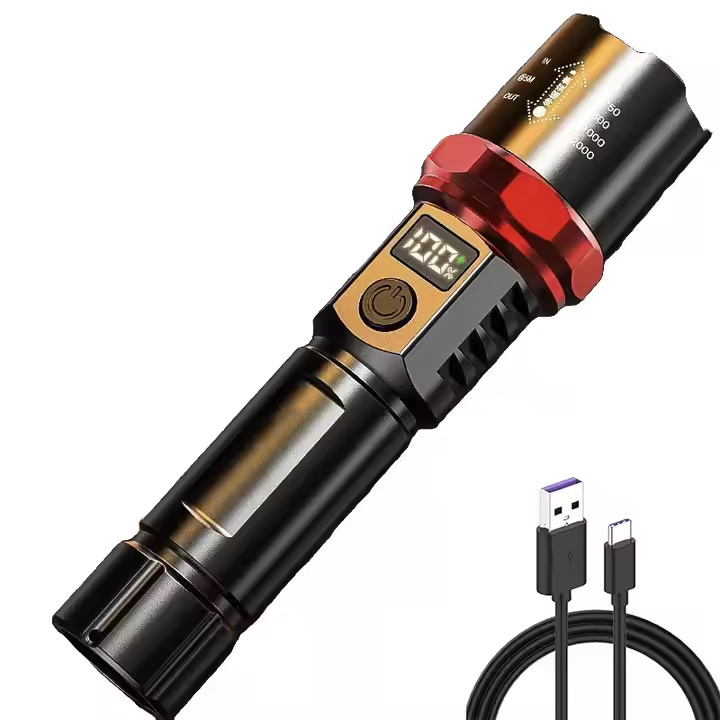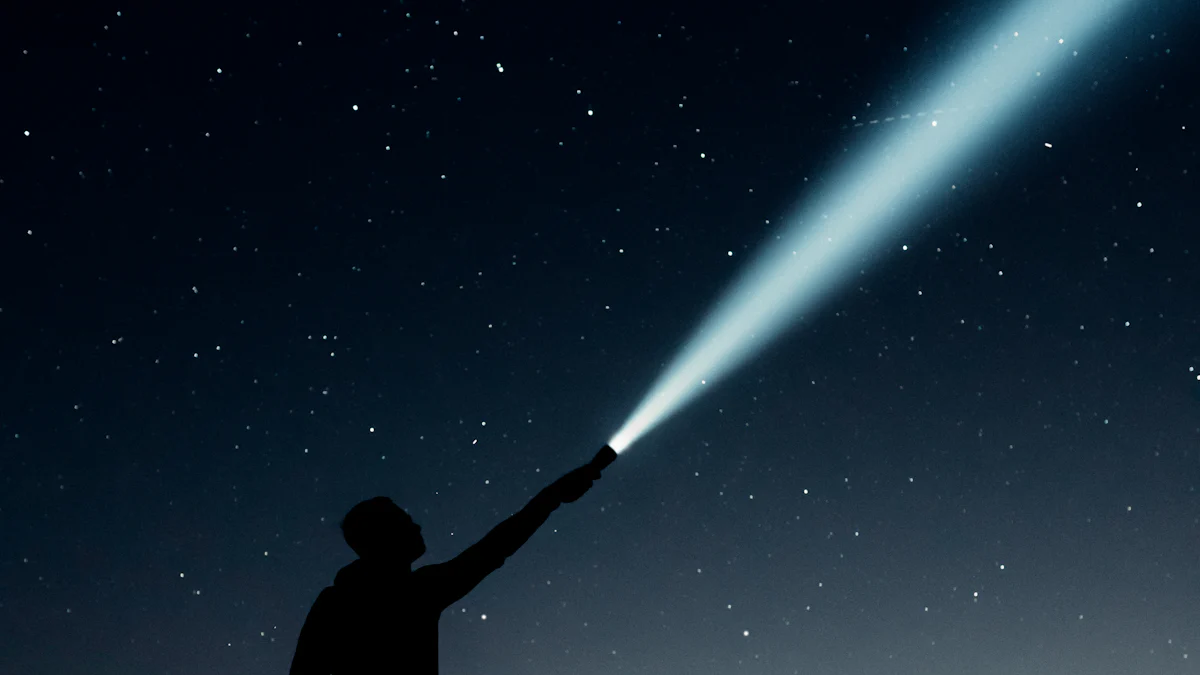What Makes a Flashlight Perfect for Outdoor Activities: Key Features to Look For

When you’re out enjoying outdoor activities like hiking or camping, a flashlight becomes your best companion. It’s not just about lighting up the dark; it’s about safety and convenience. But what makes a flashlight perfect for outdoor activities: key features to look for matter a lot. From brightness to durability, flashlights designed for the outdoors offer unmatched functionality. A good flashlight buying guide helps you pick one that suits your needs. Whether you’re exploring trails or setting up camp, the right flashlight ensures you’re always prepared.
Key Takeaways
Pick a flashlight with 200-400 lumens for outdoor use. This brightness helps you see well without hurting your eyes.
Use rechargeable lithium-ion batteries. They work longer and save money compared to throwaway batteries, perfect for long trips.
Find a flashlight with adjustable beam options. This lets you change between narrow and wide light for different tasks.
Brightness and Beam Distance

Why Lumens Matter for Outdoor Use
When choosing a flashlight for outdoor adventures, lumens and brightness are key factors. Lumens measure the total light output of a flashlight. For camping or hiking, a range of 200-400 lumens works well for most tasks. Around the campsite, lower settings between 10-100 lumens are perfect for preserving night vision. If you need to light up a trail or a larger area, a tactical flashlight with 300-1,000 lumens provides plenty of illumination for distances up to 50 feet. Anything beyond 1,000 lumens is usually unnecessary for typical outdoor activities.
💡 Tip: Look for LED flashlights with adjustable brightness settings. They let you switch between low and high lumens depending on your needs.
Choosing the Right Beam Distance
Beam distance determines how far your flashlight can project light. For outdoor use, this feature is crucial. A tactical flashlight with a focused beam is ideal for spotting objects in the distance, while a wider beam works better for close-range tasks like setting up a tent. If you’re hiking at night, a flashlight with a beam distance of 50-100 feet ensures you can see obstacles ahead without straining your eyes.
Benefits of Adjustable Beam Settings
Flashlights with adjustable beam settings offer unmatched versatility. You can switch between a narrow, focused beam for long-distance visibility and a wide beam for illuminating larger areas. This feature is especially useful when you’re transitioning between activities, like navigating a trail and cooking at your campsite. Many LED flashlights come with this functionality, making them a great choice for outdoor enthusiasts.
🔦 Pro Tip: A tactical flashlight with multiple beam settings can adapt to any situation, whether you’re exploring a dark cave or reading a map.
Battery Life and Power Source
Rechargeable vs. Disposable Options
When it comes to powering your flashlight, you’ve got two main options: rechargeable or disposable batteries. Rechargeable flashlights are a favorite for outdoor enthusiasts. They’re cost-effective in the long run and better for the environment. Lithium-ion rechargeable batteries, for instance, offer high energy density and extended lifespan, making them perfect for high-performance flashlights. Disposable batteries, like alkaline ones, are convenient for short trips but can’t match the runtime or efficiency of rechargeable options.
Here’s a quick comparison of energy-efficient battery types:
Battery Type | Key Features | Energy Efficiency |
|---|---|---|
Rechargeable Li-ion | High energy density, extended lifespan, lightweight design | High |
NiMH | Rechargeable, environmentally friendly, good balance of capacity and cost | Moderate to High |
Lithium | Superior performance, extended runtime, low self-discharge rate | Very High |
Rechargeable flashlights powered by lithium-ion batteries stand out for their lightweight design and stable voltage, ensuring consistent brightness during use.
How to Maximize Battery Life Outdoors
Maximizing battery life is crucial for extended outdoor trips. Start by using LED flashlights, as they consume less power while delivering excellent brightness. Always turn off your flashlight when it’s not in use. Overcharging can degrade rechargeable batteries, so use chargers that shut off automatically. Store your batteries in a cool, dry place to maintain their lifespan. Regularly inspect your flashlight for damage to ensure it operates efficiently.
Here are some quick tips to conserve battery life:
Use the right charger for your battery type.
Opt for LED flashlights for energy efficiency.
Turn off your flashlight when not needed.
Avoid overcharging to prevent battery degradation.
Store batteries away from heat and sunlight.
Power Source Considerations for Long Trips
For long outdoor adventures, choosing the right power source is essential. Rechargeable flashlights with lithium-ion batteries are ideal for extended trips. They provide up to 50% more runtime compared to alkaline batteries and maintain stable voltage throughout their discharge cycle. This means your flashlight will deliver consistent brightness even after hours of use. If you’re heading to remote areas, consider carrying a portable power bank or solar charger to keep your rechargeable flashlight ready for action.
Disposable batteries might seem convenient, but they’re heavier and less efficient. Lithium-ion batteries, on the other hand, are lightweight and better suited for high-performance flashlights. They waste less energy as heat and perform well under high discharge rates, making them a reliable choice for demanding outdoor activities.
Durability and Weather Resistance

Impact Resistance for Outdoor Conditions
When you're exploring rugged terrains, your flashlight needs to handle the bumps and drops that come with the adventure. A tactical flashlight designed for outdoor use should offer excellent impact resistance. Look for models tested to withstand falls from at least 1 meter. This ensures they can survive accidental drops on rocky trails or hard surfaces. Common durability issues include worn O-rings, inadequate sealing, and the absence of waterproof lubricant. These problems can compromise both durability and water resistance, so choosing a durable flashlight with high-quality construction is essential.
💡 Tip: Always check the manufacturer's specifications for impact resistance ratings to ensure your flashlight can handle tough conditions.
Waterproof Ratings and Their Importance
The importance of waterproof flashlights can't be overstated, especially when you're outdoors. Whether you're caught in a sudden downpour or crossing a stream, a waterproof flashlight ensures reliable performance. Flashlights come with different waterproof ratings, which indicate their ability to resist water exposure. Here's a quick guide to help you understand these ratings:
Rating | Description | Performance in Wet Conditions |
|---|---|---|
IPX4 | Splash resistant from any direction | Suitable for light rain or moisture exposure, but not submersion. |
IPX7 | Submersible up to 1 meter for 30 minutes | Ideal for activities near water, reliable performance in wet conditions. |
IPX8 | Submersible beyond 1 meter | Designed for demanding environments with prolonged water exposure. |
If you're planning water-based activities, go for IPX7 or IPX8-rated waterproof flashlights. They provide the durability and water resistance you need.
Materials That Ensure Longevity
The materials used in a flashlight play a big role in its durability and water resistance. Stainless steel offers excellent impact resistance and maintains its structural integrity, making it ideal for heavy-duty use. Titanium is another great option, providing exceptional strength while being lightweight and corrosion-resistant. For a cost-effective choice, consider flashlights made from high-quality polymers. These materials can handle extreme temperatures and are often eco-friendly.
Material | Durability Features | Additional Properties |
|---|---|---|
Stainless Steel | Long-lasting durability, impact resistance, maintains structural integrity | Ideal for heavy-duty applications |
Titanium | Exceptional strength-to-weight ratio, corrosion resistance | 40% less dense than stainless steel, ensures longevity in demanding environments |
Polymers | Versatile, adaptable to extreme temperatures, cost-effective | Can withstand high heat levels, eco-friendly options available |
Choosing the right material ensures your flashlight lasts through countless adventures.
🔦 Pro Tip: A tactical flashlight made from titanium or stainless steel offers the perfect balance of durability and portability.
Size and Portability
Compact vs. Full-Sized Flashlights
When it comes to outdoor adventures, the size of your flashlight matters. Compact flashlights, often referred to as EDC (Everyday Carry) flashlights, are perfect for activities like hiking or camping. They’re small enough to fit in your pocket but powerful enough to light up your path. These flashlights are built to handle rugged conditions, making them reliable companions for navigating trails or setting up camp after dark.
🛠 Note: Navigating through trails or campsites without proper lighting can be risky. A compact flashlight ensures safety by helping you avoid obstacles like rocks or tree roots.
Full-sized flashlights, on the other hand, offer higher brightness and longer battery life. They’re great for situations where you need extended illumination, such as exploring caves or signaling for help. However, their larger size makes them less portable. If you’re looking for a balance between power and portability, compact flashlights are the way to go.
Lightweight Options for Outdoor Activities
The weight of your flashlight can make or break your outdoor experience. A lightweight flashlight is easier to carry, especially during activities like hiking or fishing, where mobility is key. For example, a flashlight weighing just 1.65 oz, like the Zero Flashlight, is ideal for everyday carry. Its dual clip design lets you attach it to your cap or wrist, giving you hands-free convenience without sacrificing performance.
Lightweight flashlights don’t compromise on durability or brightness. Many models use advanced materials like titanium or high-quality polymers to keep the weight down while maintaining excellent durability. This makes them perfect for long trips where every ounce counts.
Storage and Carrying Tips
Proper storage and carrying methods can extend the life of your flashlight. Here are some tips to keep your flashlight and batteries in top condition during outdoor trips:
Store batteries in a cool, dry place to prevent overheating.
Keep batteries away from metal objects to avoid short circuits.
Remove batteries from flashlights not in use for long periods to prevent leakage.
Use insulated containers for spare batteries to protect them from extreme temperatures.
For carrying, consider using a holster or lanyard to keep your flashlight within easy reach. Compact flashlights can also fit snugly in your pocket or backpack, ensuring they’re always accessible when you need them.
Additional Features
Multiple Light Modes for Versatility
When you're outdoors, having a flashlight with multiple lighting modes can make all the difference. These modes let you adapt to different situations with ease. For example, a tactical flashlight often includes high, medium, and low brightness settings. This flexibility allows you to conserve battery life when you don’t need maximum lumens. Some flashlights also feature red-light modes, which are perfect for preserving your night vision. Hunters especially benefit from this feature since it provides visibility without startling wildlife during early morning or late evening outings.
In emergencies, special modes like SOS, strobe, or beacon can be lifesavers. These settings help you signal for help or disorient potential threats. Whether you're navigating a dark trail or dealing with an unexpected situation, multiple lighting modes ensure you're always prepared.
🔦 Pro Tip: Look for a tactical flashlight with red-light and SOS modes for maximum versatility.
User-Friendly Controls for Easy Operation
User-friendly controls make your flashlight much easier to use, especially in high-pressure situations. Imagine fumbling with complicated buttons in the dark—it’s frustrating, right? Flashlights with intuitive designs solve this problem. Many models include simple on/off switches or separate buttons for different modes. For instance, the Zero Flashlight features a dual-button system that lets you quickly adjust brightness or activate specific modes. It even remembers your last brightness setting, so you don’t have to reset it every time.
Here’s why user-friendly controls matter:
They provide quick access to essential functions.
Separate buttons for modes reduce confusion.
Memory features save time in emergencies.
With these features, you can focus on your adventure instead of struggling with your flashlight.
Built-in Extras for Added Functionality
Modern flashlights come packed with extras that go beyond basic lighting. High-end models often include built-in compasses, which are handy for navigation. Some even double as power banks with capacities ranging from 10,000 to 36,800mAh. These can charge your phone or other devices during long trips. Dual USB outputs allow you to charge multiple gadgets at once, making them perfect for group outings. Waterproof and dustproof designs add another layer of durability, ensuring your flashlight performs well in harsh conditions.
Other extras, like 2 LED flashlights with Steady-SOS-Strobe modes, enhance functionality. These features make your flashlight a multi-purpose tool, ideal for tactical use or emergencies. Whether you're camping, hiking, or exploring, these built-in additions elevate your outdoor experience.
💡 Tip: Choose a tactical flashlight with a waterproof design and power bank functionality for ultimate convenience.
Choosing the right flashlight for outdoor activities can make all the difference. Focus on key features like brightness, battery life, durability, size, and extra functionalities. Think about your specific needs—whether it’s camping, hiking, or caving. A compact, lightweight flashlight with multiple modes and reliable battery life ensures safety and convenience. Investing in a high-quality flashlight offers long-term benefits like enhanced brightness, durability, and versatility. It’s a small tool that can elevate your outdoor experiences and keep you prepared for any situation.
FAQ
How many lumens do you need for outdoor activities?
For most outdoor tasks, 200-400 lumens work well. Hiking or exploring trails may require 300-1,000 lumens for better visibility over longer distances.
💡 Tip: Choose a flashlight with adjustable brightness for versatility.
What’s the best way to store flashlights during trips?
Keep your flashlight in a dry, accessible spot like a backpack pocket or holster. Remove batteries if not in use for long periods to prevent leakage.
Can a flashlight double as a power bank?
Yes, some flashlights include built-in power bank functionality. These models can charge devices like phones, making them perfect for extended outdoor adventures.
🔋 Note: Look for dual USB outputs for charging multiple devices simultaneously.
See Also
Your Go-To Guide for Selecting Outdoor Flashlights and Headlamps
How to Choose the Ideal Flashlight or Headlamp for Outdoors
A Complete Guide to Selecting the Right Promotional Flashlight
Five Essential Tips for Picking the Right Flashlight or Headlamp
Comprehensive Insights on Wholesale Flashlights: Durability and Brightness
